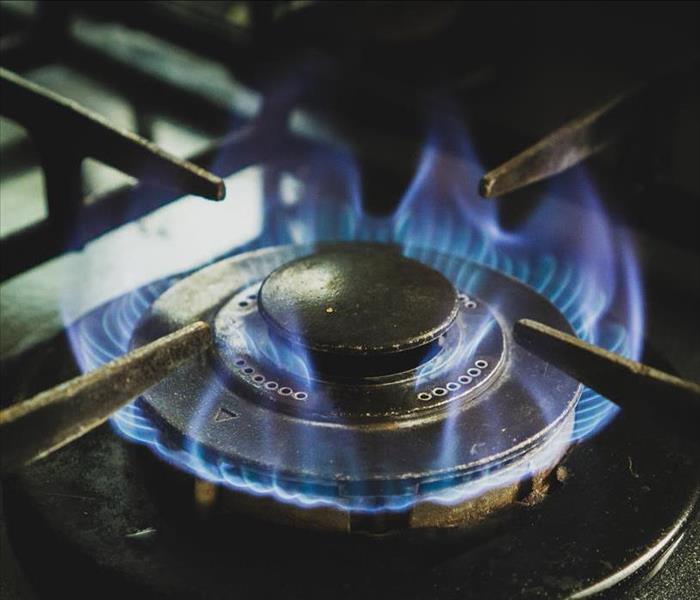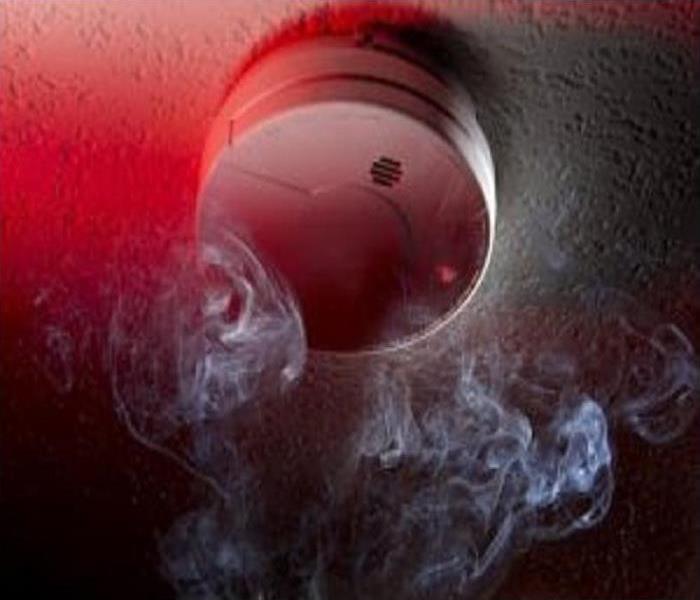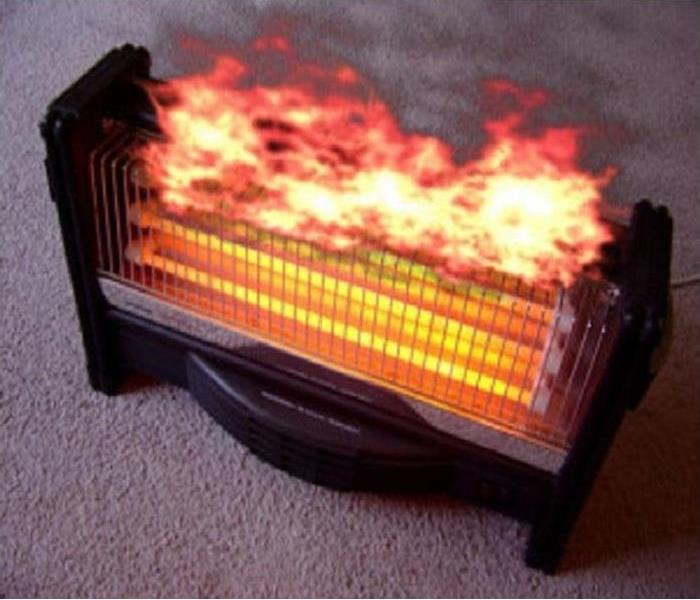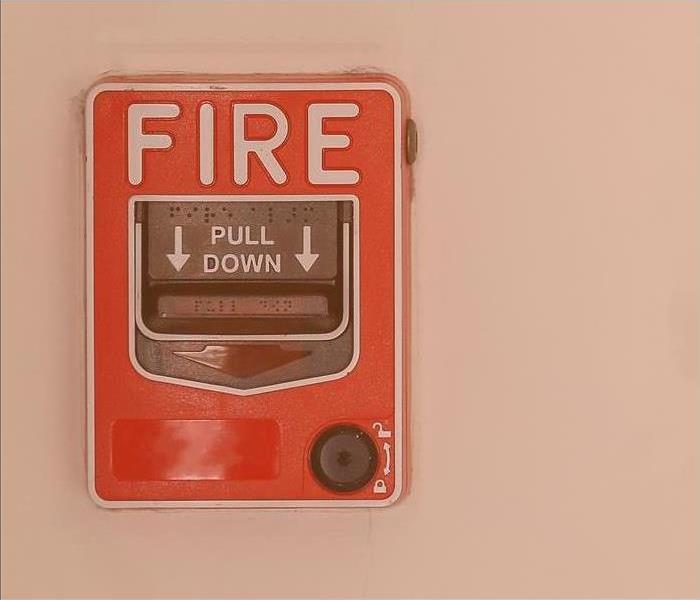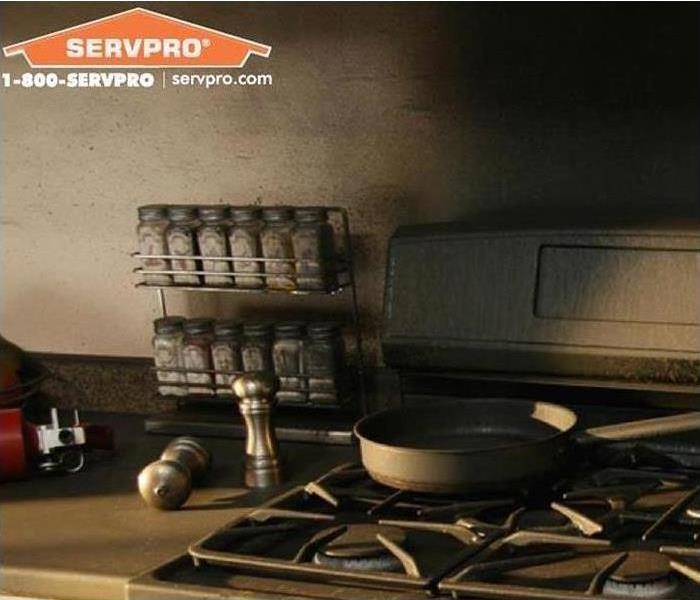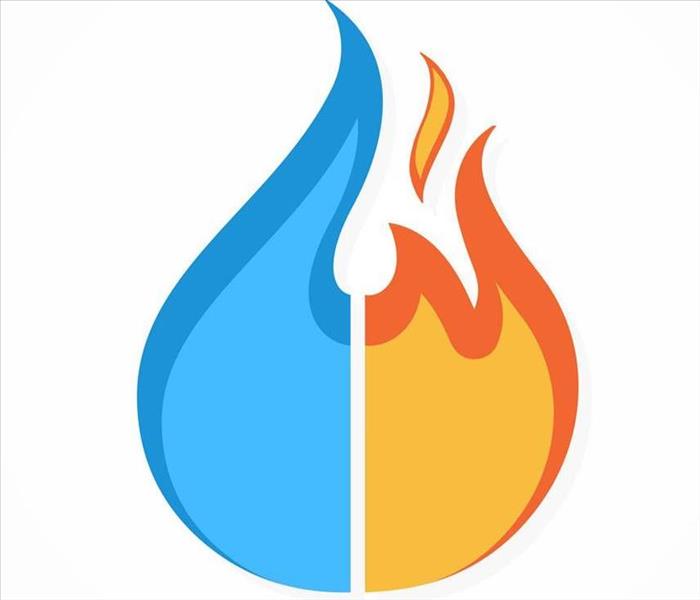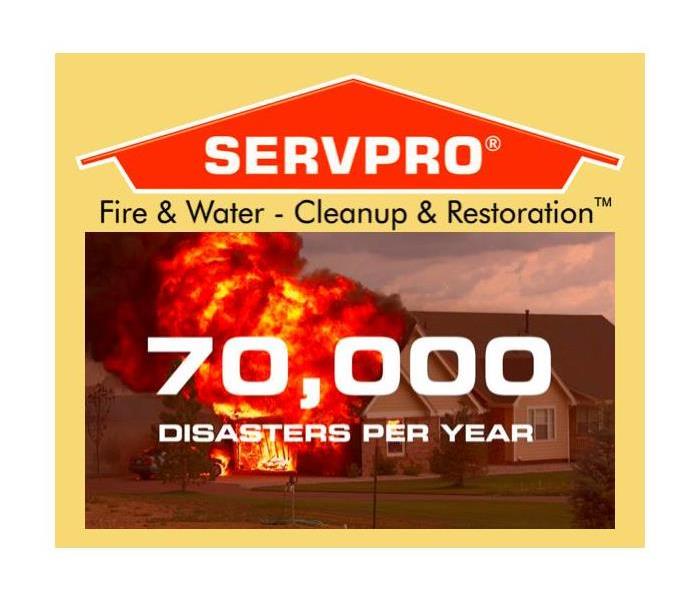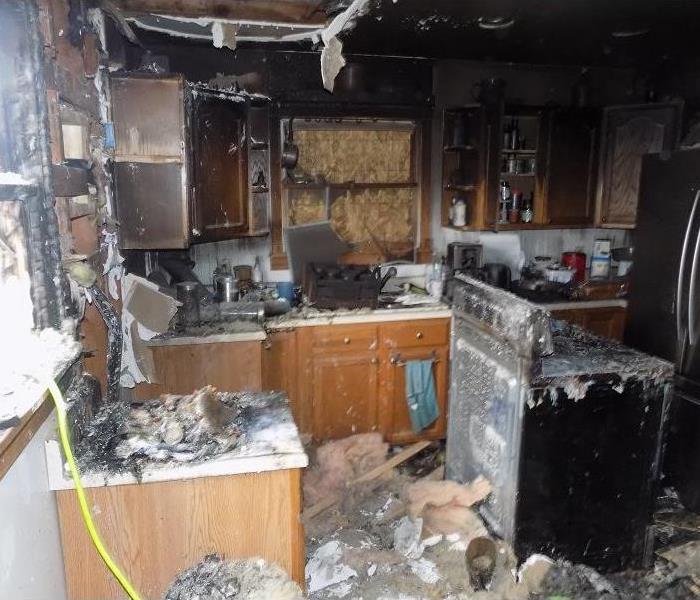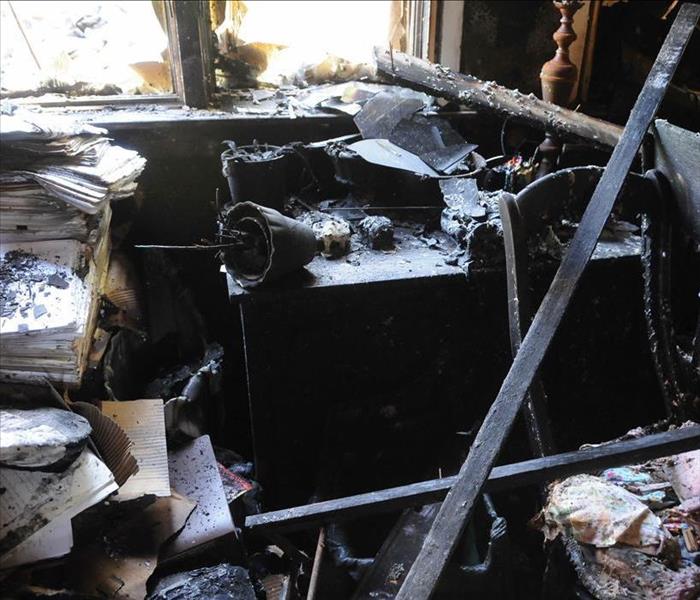Recent Fire Damage Posts
Avoiding Fire Damage to Your Home Or Business in the Spring Season
3/25/2024 (Permalink)
Spring is upon us, bringing warmer weather and a host of outdoor activities. However, along with the joys of springtime, it's important to remain vigilant against potential fire hazards that could threaten your home. Here are three key fire hazards to be mindful of during the spring season:
1. Grilling Safety: As the weather warms up, many of us will be eager to fire up the grill for outdoor cooking. However, it's essential to use caution to prevent dangerous fires. Make sure your grill is placed away from any flammable materials, such as overhanging branches or wooden decks. Always keep a fire extinguisher nearby and never leave the grill unattended while in use.
2. Yard Debris Management: Spring cleaning often involves clearing away yard debris like dry leaves, branches, and dead vegetation. While tidying up your outdoor space is important, it's crucial to dispose of these materials properly. Avoid burning yard waste on windy days, and always adhere to local regulations for outdoor burning. Consider composting or using designated disposal methods to reduce the risk of accidental fires.
3. Electrical Equipment Usage: With the arrival of spring, there's typically an uptick in outdoor activities that require the use of electrical equipment, such as lawnmowers, trimmers, and power tools. Before using these devices, take the time to inspect their electrical cords and outlets for any signs of damage or wear. Avoid overloading circuits with too many devices, and ensure that electrical equipment is kept away from water sources at all times.
By remaining vigilant and addressing these common fire hazards, you can help protect your home and loved ones throughout the spring season. Remember to install and maintain working smoke detectors in your home, and develop a family fire escape plan in case of emergencies. Should you ever experience fire damage, you can trust SERVPRO to provide professional restoration and cleanup services. Stay safe and enjoy the spring season!
Where Should Home Fire Alarms Go?
7/31/2022 (Permalink)
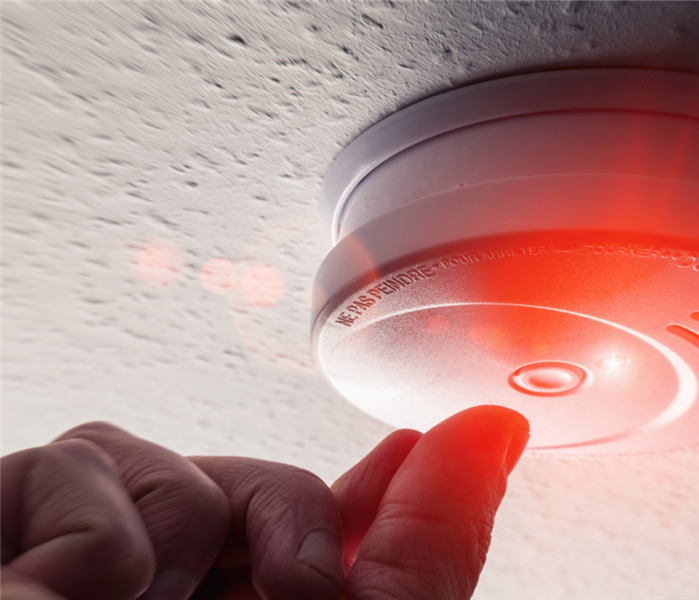 Home Fire Alarm set inside every bedroom of Vermilion County Home
Home Fire Alarm set inside every bedroom of Vermilion County Home
While many homes in Danville, IL come already installed with all the smoke alarms you need to make sure you are keeping your family safe. As more research has been conducted over the years on fires and how they spread, requirements have changed. Many older homes do not meet these standards which can be dangerous in the case a fire does occur. Keep your family safe by ensuring a fire alarm is located in the following four locations! Bedrooms - The National Fire Protection Association suggests the placement of a fire alarm in every bedroom of the house. This ensures that if a fire occurs while your family is asleep, the alarms will wake quickly wake up everyone. Outside Every Sleeping Area - Not only should alarms be inside every bedroom, but there should also be a smoke alarm right outside the room or any other sleeping areas as well. This is so you can react and start to escape before any fire or smoke even enters your room. 10 Feet From Your Kitchen - Kitchen fires result in approximately 50 percent of all home fires, many of which result in serious fire damage to your home. Make sure a fire alarm is located 10 feet from your kitchen rather than inside it since smoke or steam from cooking can easily trigger it. Every Level of Your Home - Ensure that there is as least one smoke alarm on every level of your home. Don’t forget your basement! Serious fire and smoke damage can occur from an undetected fire that starts in the basement. It doesn’t take long for a house fire to quickly get out of hand! That’s why it is so important to have all the required fire alarms installed so you can quickly get everyone out of your house and get in contact with the fire department and a fire restoration company to minimize the fire damage to your home.
What to Do if You Smell Natural Gas in Your Home
2/28/2022 (Permalink)
If You Smell Natural Gas in Your House, What Should You Do?
If you have appliances in your Vermilion County home that are operated using gas, it is possible that a leak could occur. If you notice a gas smell in your house, you should take some precautions to prevent starting a gas fire.
1. Turn Off the Stove
A common source of gas in your home is the stove. If you have a gas stove, make sure that it is turned off. If the gas is coming from this location that might be all you need to do to fix the problem.
2. Turn Off the Gas Meter
If natural gas is leaking from somewhere else in your home, you should turn the gas off at the meter. This should keep the gas from continuing to fill your home.
3. Open Doors and Windows
To keep the gas from building up and creating the potential for a gas fire explosion, you should open all of the windows and doors. This allows the house to ventilate and will make it easier for the gas to leave your home.
4. Don’t Use the Electricity
If you have a gas leak in your home, the built-up gas is highly flammable. Don’t turn on any electrical objects, including the lights, and don’t handle any plugs or outlets. Even a small spark could turn into a big gas explosion.
5. Call a Professional
After leaving the house, you can contact emergency restoration services to take care of the natural gas leak in your home. It is important that you have a professional inspect the house to make sure the built-up gas has dissipated, and the source of the leak is repaired.
Because you cannot see if there is a gas leak, an unusual smell will likely be the first indication that there is a problem. A gas fire can start and spread easily, so make sure to follow these steps to keep you and your family safe.
What is Soot and Why Does It Form?
1/4/2022 (Permalink)
Clean-Up from Fire & Smoke Damage Calls for Professional Help
Dealing with soot is one of the most time-consuming parts of fire damage restoration. Residue quickly settles on surfaces after fire damage, and the cleanup is a genuine struggle for homeowners in Vermilion County who are dealing with the aftermath. However, what is soot, why does it form after the fire?
Soot Damage
Soot is the fine brown or black powder that clings to and discolors surfaces in the home after fire damage in Vermilion County. Soot is what gives items that charred and blackened look. Smoke is a by-product of the incomplete combustion of materials; as wood, paper, plastic, and other materials burn during a house fire, they produce residues and release particles into the atmosphere.
The composition of soot makes it slightly sticky, which means it clings to surfaces and is difficult to remove. As well as looking unsightly, this residue reduces air quality, and a smoke-damaged house does not feel like a home. SERVPRO is on hand to help with fire damage cleanup and restore your home “Like it never even happened.”
Whether or not an item is salvageable after smoke damage depends on how porous the material is. It is far harder to clean residue from a weathered and aged wooden table than to clean it from a smooth glass or polished metal surface.
Trained Fire Damage Restoration Technicians
Our IICRC-certified technicians arrive ready to thoroughly assess your property and devise the best cleaning plan for you. We advise you on which items are salvageable from soot damage and which are not. SERVPRO trains our technicians in a range of cleaning techniques and equips them with everything they need to scrub, scrape, and wipe soot from the surfaces in your home.
After cleaning, we set to work deodorizing your home as well. We understand that it is hard to settle back into your house when it smells of smoke. We have thermal foggers, ozone generators, and air scrubbers on hand to rid your home of smoky smells and leave it fresh once more.
For help with soot and smells in Vermilion County, call SERVPRO of Vermilion County at 217-443-0077
Buying A Smart Smoke Detector: How Smart Is It?
11/30/2021 (Permalink)
If you’re looking to modernize your Vermilion County home, you’ve probably heard of a smart smoke alarm. Compared to a traditional smoke detector, a connected one offers benefits allowed by modern technology. Understanding what makes them “smart” will allow you to make an informed decision if it’s worth buying one yourself.
Features of a Smart Alarm
There is no single model of smart smoke detector. It is worth shopping around to find a model that has all you want. They offer an assortment of convenience and advanced monitoring depending on the year and model:
- Pinging connected devices if smoke or carbon monoxide is detected
- Advanced technologies for faster smoke detection and self-testing
- No alarm beeping when the battery is low in favor of an app notification
- Voice-activated personal assistant integration around your home with Amazon Alexa, Google Assistant or Apple HomeKit for convenience and functionality when there is no danger
Stop a Fire Yourself Even When Not Home
The top benefit of a smart smoke alarm is the ability to act yourself even while away from home. A neighbor may call emergency services for you, but the problem has already flared out of control when it becomes noticeable to other households.
With the modern sensors and an immediate application alert, you will know exactly where the fire is so you can make the call to deploy fire services if the fire is major. You can also deploy nearby neighbors or relatives to extinguish minor fires before they become unmanageable no matter how far away you are.
Fight Fire Using Your Fingertips
By connecting a smart alarm, your phone can become a command center for your entire home. Unfortunately, a fire still damages your home even if caught earlier. Using its most basic feature, your phone can call SERVPRO of Vermilion County to clean up and repair any damage.
Digitally monitoring your home is a benefit of the digital age. Fire safety is greatly improved with the smart smoke alarm technology offered nowadays.
How does a puff back occur?
11/8/2021 (Permalink)
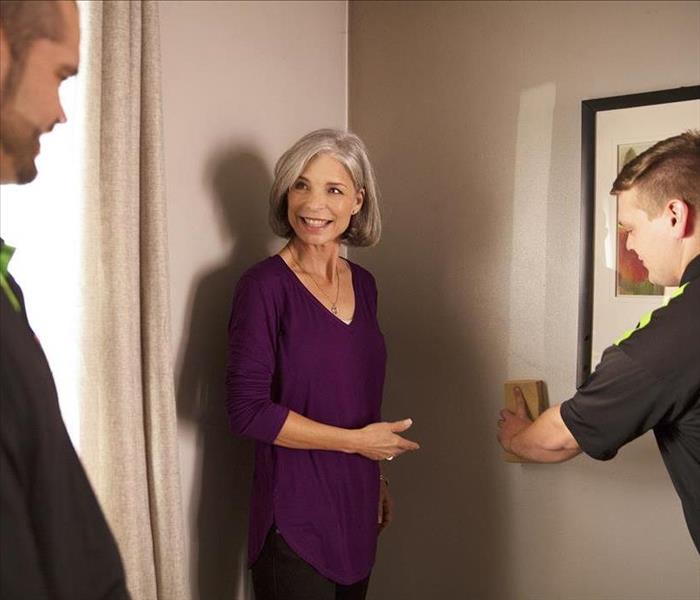 A puff back can spread soot throughout your home.
A puff back can spread soot throughout your home.
A puff back happens when an oil burner doesn't immediately ignite and oil fumes are allowed to build up before ignition. This results in an explosion similar to what happens when a car backfires. It may also occur from a buildup of debris, causing an explosion when the furnace turns on. In either case, the explosion forces soot and debris through the furnace or the boiler's exhaust system and into your home or business. The problem is worse with forced hot air systems as the heating ducts spread black soot into every corner of your home, with the same efficiency that they spread heat throughout your property.
Fact #1: Most puff back cleanups are covered by insurance.
The professionals at SERVPRO of Vermilion County can walk you through the claim process step by step and make it "Like it never even happened.” In fact, our customers often tell us that their properties look and smell cleaner than it ever did before!
During a puff back event, oil based soot typically covers all areas of the property including drapes, bedding, furniture, clothing, cabinetry, ceilings, walls and floors, all of which is extremely difficult to remove. In most instances, you will know that you’ve had a puff back! But there may be times when it is harder to detect because the soot coverage can range from a light dusting to a concentrated dark appearance especially on flat surfaces like counter tops. While you may be tempted to clean the affected area yourself, we don’t recommend you do that as the "dust" will likely re-appear hours afterwards. There may be a strong odor in the affected rooms. Don’t be fooled that the dust is only where you see it. It travels everywhere that the air does—into every nook and cranny. Sometimes you will find what you think are black “spider webs” in the corners of a room. These marks are actually a collection of the sticky soot. At SERVPRO of Vermilion County, we have the appropriate equipment, knowledge, experience and training to properly get the job done.
Fact # 2: The cost to repair a furnace will NOT likely be covered by insurance.
Puff backs create an unhealthy environment for everyone and you should not touch or breathe the soot or particles that are floating through the air and landing on the surfaces of your property.
Fact #3: Most oil companies can inspect and service the boiler at your property, which greatly reduces the chances of a puff back. However, there is no guarantee against such an occurrence.
How to Properly Clean Your Belongings After a Fire
8/31/2021 (Permalink)
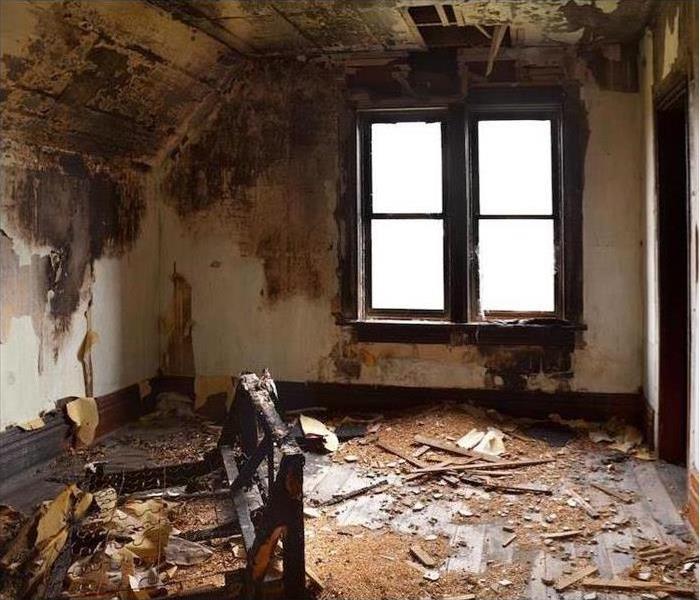 After a fire, your belongings will need to be properly cleaned in order to salvage them
After a fire, your belongings will need to be properly cleaned in order to salvage them
If you’ve had the unfortunate experience of dealing with a fire in your Vermilion County home, you may now be focused on the aftermath of it all, which involves salvaging your belongings. Some people assume they must throw out their clothes, books, and other items simply because they smell like smoke, but that isn’t always the case. Although the smell is bothersome, dry cleaning is one of several ways to remove the odor and restore items.
Have Your Clothes Professionally Washed
If you’ve tried washing clothes in laundry detergent and the scent still lingers, you may want to consider enlisting help from professionals. Rather than attempting to remove the odor and any stains from your shirts, pants, and other accessories, bring the items to the dry cleaning company where experts can use various products that are meant to clean and deodorize clothes.
Use a Scrub Brush
When you’re trying to complete a thorough content cleaning of some of your other belongings, consider using a scrub brush to scrub away at any of the soot that may be left behind on items. It’s possible to use a scrub brush on many products, such as:
- Tables
- Chairs
- Bureaus
- Nightstands
- Hardback books
Before you start scrubbing, it’s wise to put a mask on that will cover both your mouth and your nose so that you’re not breathing in the heavy scent of smoke while focusing on the cleaning process.
If there are a lot of items that must be cleaned but you don’t have time to take care of it all in one day, you could consider checking out content storage options in Richland, WA. Storage facilities may allow you to put those items away until you’re ready to give them the thorough cleaning they need.
After experiencing a fire in the home, you may now be focused on salvaging items and restoring the home back to its original condition. If you’re worried you’ll have to throw away some of your clothes and other valuable, important items, consider other cleaning alternatives, such as dry cleaning for clothes that currently smell like smoke.
Behavior of Smoke
7/21/2021 (Permalink)
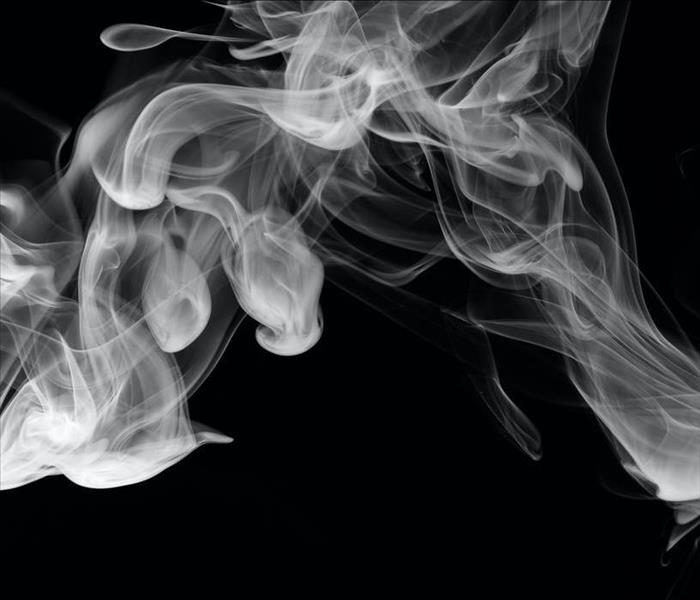 Smoke can leave odors and cause additional damages
Smoke can leave odors and cause additional damages
The damage to your property following a fire can often be complicated due to the unique behavior of smoke. There are two different types of smoke-wet and dry. As a result, there are different types of soot residue after a fire.
SERVPRO® of Champaign/Urbana is thoroughly trained in fire cleanup and restoration and know the different types of smoke and their behavior patterns. Knowing this information is vital to proper restoration. Before restoration begins, we will survey the loss to determine the extent of impact from fire, smoke, heat, and moisture on the building materials and contents. The soot will then be tested to determine which type of smoke damage occurred. Pretesting determines the proper cleaning method and allows us to focus on saving your precious items.
SERVPRO® of Champaign/Urbana knows smoke can penetrate various cavities within the structure, causing hidden damage and odor. Their knowledge of building systems helps them investigate how far smoke damage may have spread. The following are additional facts you may not know about smoke.
- Hot smoke migrates to cooler areas and upper levels of a structure.
- Smoke flows around plumbing systems, seeping through the holes used by pipes to go from floor to floor.
- The type of smoke may greatly affect the restoration process.
Types of Smoke:
Wet Smoke (Plastic and Rubber)
Low heat, smoldering, pungent odor, sticky, smeary. Smoke webs are more difficult to clean.
Dry Smoke (Paper and Wood)
Fast-burning, high temperatures; heat rises, therefore smoke rises.
Protein Fire Residue (Produced by evaporation of material rather than from a fire)
Virtually invisible, discolors paints and varnishes, extreme pungent odor.
Fuel Oil Soot (Furnace Puff Backs)
While “puff backs” can create havoc for homeowners, SERVPRO® of Champaign/Urbana can, in most cases, restore the contents and structure quickly.
Other Types (Tear gas, fingerprint powder, and fire extinguisher residue)
Special loss situations require special care.
SERVPRO® of Champaign/Urbana is trained to handle even the toughest losses. If your commercial property suffers fire or smoke damage, trust us to help make it “Like it never even happened.”
Behavior of Smoke
7/5/2021 (Permalink)
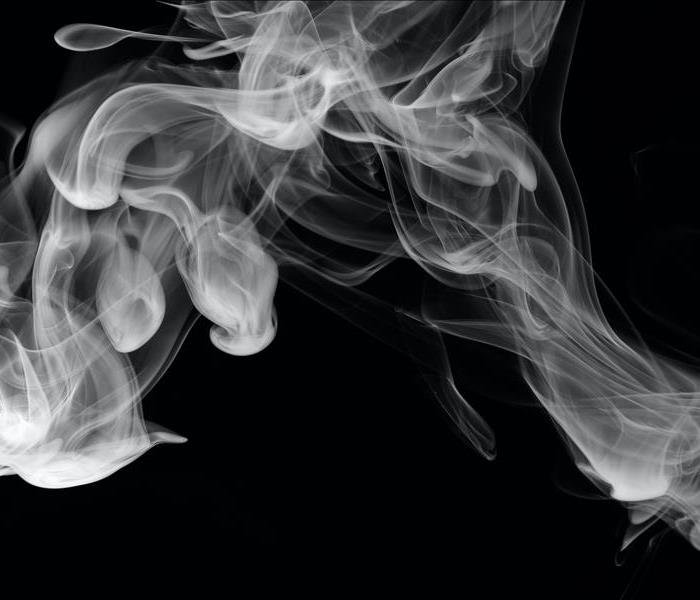 Smoke can leave odors and cause additional damages
Smoke can leave odors and cause additional damages
The damage to your property following a fire can often be complicated due to the unique behavior of smoke. There are two different types of smoke-wet and dry. As a result, there are different types of soot residue after a fire.
SERVPRO® of Champaign/Urbana is thoroughly trained in fire cleanup and restoration and know the different types of smoke and their behavior patterns. Knowing this information is vital to proper restoration. Before restoration begins, we will survey the loss to determine the extent of impact from fire, smoke, heat, and moisture on the building materials and contents. The soot will then be tested to determine which type of smoke damage occurred. Pretesting determines the proper cleaning method and allows us to focus on saving your precious items.
SERVPRO® of Champaign/Urbana knows smoke can penetrate various cavities within the structure, causing hidden damage and odor. Their knowledge of building systems helps them investigate how far smoke damage may have spread. The following are additional facts you may not know about smoke.
- Hot smoke migrates to cooler areas and upper levels of a structure.
- Smoke flows around plumbing systems, seeping through the holes used by pipes to go from floor to floor.
- The type of smoke may greatly affect the restoration process.
Types of Smoke:
Wet Smoke (Plastic and Rubber)
Low heat, smoldering, pungent odor, sticky, smeary. Smoke webs are more difficult to clean.
Dry Smoke (Paper and Wood)
Fast-burning, high temperatures; heat rises, therefore smoke rises.
Protein Fire Residue (Produced by evaporation of material rather than from a fire)
Virtually invisible, discolors paints and varnishes, extreme pungent odor.
Fuel Oil Soot (Furnace Puff Backs)
While “puff backs” can create havoc for homeowners, SERVPRO® of Champaign/Urbana can, in most cases, restore the contents and structure quickly.
Other Types (Tear gas, fingerprint powder, and fire extinguisher residue)
Special loss situations require special care.
SERVPRO® of Champaign/Urbana is trained to handle even the toughest losses. If your commercial property suffers fire or smoke damage, trust us to help make it “Like it never even happened.”
Make a Plan and Stick to It
7/1/2021 (Permalink)
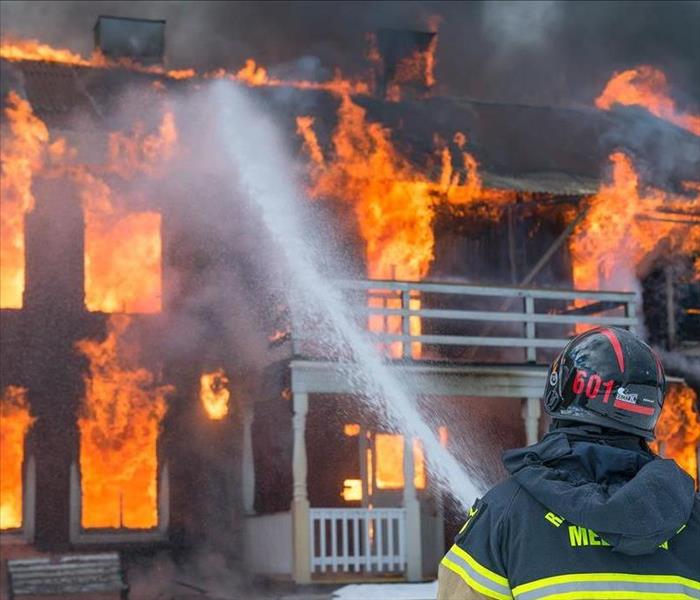 House fires can be devastating, make a plan and be prepared
House fires can be devastating, make a plan and be prepared
Fire experts agree that people have as little as two minutes to escape a burning building before it is too late to exit safely. When it comes to a fire escape plan, every second counts. In a matter of seconds, even the smallest flame can become a massive blaze. The American Cross conducted a survey that found only 26% of families have made and practiced their fire escape plans. If you don't have a plan in place for your home or business, use these tips to develop one!
Draw a map of each level of your home indicating exits (windows and doors)
Consider escape ladders for sleeping areas on higher floors. Store them near the window. If you buy these ladders, make sure they are tested by a reliable testing laboratory
Pick a meeting place outside that keeps a safe distance from your home. Mark it well so everyone remembers where it is
Teach the youngest members of your family how to escape on their own if no one is able to help them. Make accommodations for the elderly, disabled, and your pets
Practice your plan at least twice a year (once during the day and once at nighttime)
Fires can be unpredictable, so your escape plan shouldn't be! Restoring your property after a fire shouldn't be difficult either. That's why SERVPRO of Vermilion County works so efficiently to cleanup your property ASAP after damage or a loss.
Let's Talk Smoke Alarms
3/1/2021 (Permalink)
The fire detection and prevention tools that work best are the ones that save the most lives. This is why smoke detectors are so important. However, even if you have multiple detectors installed throughout your property, they are useless unless they are working properly. Even if you believe your detectors are on and working, never take it for granted, you don’t want to wait until an actual fire starts to find out for sure. Several times a year you should test your alarms to ensure they are working as intended . Review the following steps to learn how to correctly test your alarm and fix it if it isn’t working.
TEST ALARMS REGULARLY
The first thing you should do is let everyone else in your home know that you are testing an alarm. You don’t want a member of your family to call the local fire department when there is no fire to put out. Next, you should have someone go to the opposite end of the property to see if they can hear the alarm from the furthest point away from its location. Once they are in position, push and hold the test button for a few seconds until the alarm starts going off.
TEST AND REPLACE BATTERIES
If the alarm doesn’t go off, the first thing you should do is replace the batteries and check to see if the device is on. After doing so, test the alarm again. If it still isn’t working, you may have a faulty device that needs to be replaced. Repeat this process with all the alarms in your home. You should also get a smoke detector aerosol spray can and spray near each detector. This will let you know if your device is working correctly. Unfortunately, fires can still happen. In the event you should suffer a fire call one of our friendly staff at SERVPRO of Vermilion County today at 217-443-0077. We are here to help!
Space Heating Hazards
1/5/2021 (Permalink)
As colder weather starts to set in, SERVPRO of Vermilion County would like to encourage you to practice space heater safety and know the potential risks associated with home heating equipment. Home fires occur more in the winter months than any other time of year. According to the National Fire Protection Association, heating equipment is one of the leading causes of home fire deaths and space heaters account for 4 out of 5 home heating fire deaths.
Follow these tips to stay safe while heating your home:
- Have heating equipment and chimneys cleaned and inspected annually by a qualified professional.
- Keep anything that can burn at least 3 ft. away from heating equipment, like the furnace, fireplace, wood stove or portable space heater.
- Portable space heaters should be turned OFF every time you leave the room and before going to bed.
- Never plug a space heater in a power strip.
- Install carbon monoxide detectors to avoid carbon monoxide poisoning.
- Never use an oven to heat your home.
For portable electric heaters:
- Place them on a solid, flat surface, away from high traffic areas and doorways.
- Use and purchase heaters with an automatic shut off so if they are tipped over they will shut off.
- Plug power cords directly into outlets and never into an extension cord.
- Inspect for cracked or damaged, broken plugs or loose connections; replace before using.
Heating Fire Facts:
- Most home heating fire deaths (86%) involved stationary or portable space heaters.
- The leading factor contributing to home heating fires (27%) was failure to clean, principally from solid-fueled heating equipment, primarily chimneys.
- The leading factor contributing to ignition for home heating fire deaths (54%) was heating equipment too close to things that can burn, such as upholstered furniture, clothing, mattress, or bedding.
- Nearly half (48%) of all home heating fires occurred in December, January and February.
In the case of fire and water damage, SERVPRO of Vermilion County our team of experts have the equipment, tools, training and expertise to take control of the situation and begin the water and fire damage restoration process before advanced secondary damage begins to take place.
Candle with Care
12/1/2020 (Permalink)
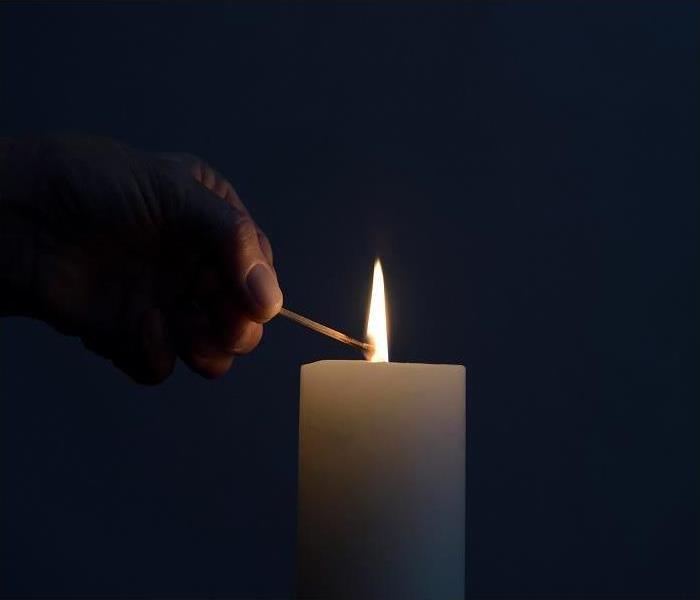 Candle Safety
Candle Safety
Candles may be pretty to look at but they are a cause of home fires — and home fire deaths. Remember, a candle is an open flame, which means that it can easily ignite anything that can burn.
Candle FACTS:
- December is the peak month for home candle fires.
- More than 1/3 of home candle fires started in the bedroom
- Three of every five candle fires start when things that can burn are too close to the candle
If you do burn candles, make sure that you...
- Blow out all candles when you leave the room or go to bed.
- Keep candles at least 1 foot away from anything that can burn.
- Use candle holders that are sturdy, and won’t tip over easily.
- Put candle holders on a sturdy, uncluttered surface.
- Light candles carefully. Keep your hair and any loose clothing away from the flame.
- Don’t burn a candle all the way down, discard before it gets too close to the holder
- Never use a candle if oxygen is used in the home.
- Have flashlights and battery-powered lighting ready to use during a power outage.
Should disaster strike and you become a victim of a home fire, call SERVPRO of Vermilion County at 217-443-0077 we are Here To Help and Faster To Any Disaster.
Choosing the right type of fire extinguisher
11/10/2020 (Permalink)
Getting the right type of fire extinguisher is very important for your home or business. What is the right type? The most common fire extinguisher is a stored pressure fire extinguisher. However, there’s another type of fire extinguisher, cartridge-operated, that we will discuss in this blog. A cartridge-operated extinguisher looks and functions differently than a stored pressure extinguisher. It’s important you understand the differences in these extinguishers so that you can safely and accurately use the fire extinguisher in the event of an emergency.
Operating a Fire Extinguisher
A stored pressure extinguisher has the agent and pressure mixed in the same container inside of the extinguisher. A cartridge-operated extinguisher has just powder/agent inside and there is a separate pressure cartridge that has to be activated to pressurize the extinguisher. The way these extinguishers are manufactured affects the way they are operated. A stored pressure extinguisher can be operated by using the PASS method. The cartridge-operated extinguisher has an added step. Since there is a pressure cartridge, you’ll need to activate the cartridge first, which immediately adds pressure to the inside of the extinguisher. Once the cartridge has been activated, you can then aim, squeeze, and sweep to extinguish the flames.
Inspection & Maintenance
The inspection and maintenance are different for both extinguishers. A stored pressure fire extinguisher has a quicker inspection process, only taking about ten steps. They need an internal examination every six years and a hydrostatic test every twelve years. A cartridge-operated fire extinguisher has a longer inspection process, with about 43 total steps. There is a hydrostatic test needed every 12 years, but a 6-year internal examination is not required.
Both types of extinguishers should be inspected every month by an appointed individual at your facility. The monthly inspection is done to ensure the extinguishers:
- Are in their designated locations
- Are accessible
- Instruction labels are legible
- All seals and tamper indicators are sound
- There are no signs of corrosion, damage, leakage, or clogging
You will need to keep a written record of each manual inspection.
Why Choose a Cartridge-Operated Extinguisher?
This is a common question asked because cartridge-operated extinguishers are extremely unfamiliar to the public. However, cartridge-operated extinguishers do well in facilities with low temperatures or places exposed to adverse conditions. While cartridge-operated extinguishers are more durable, they are also heavier. They have fewer accidental discharges, but tampering with the agent is possible since the pressure is not stored inside of the extinguisher. Newer cartridge-operated extinguishers include an indicator, so you’re aware when pressure has been activated; however, it is not required. The pressure gauge on a stored-pressure extinguisher is still considered an advantage.
Should you have the unfortunate chance of having a fire at your home or business give SERVPRO of Vermilion County a call today at 217-443-0077. Our friendly staff is here to help with 30 years of experience in the restoration business!
5 Unexpected Causes of House Fires
9/1/2020 (Permalink)
Here at SERVPRO of Vermilion County we have restored many homes and commercial businesses from fires that started from different sources. House fires are a serious danger and homeowners are wise to protect themselves from the most common causes. To avoid some of the usual fire starters, make sure to maintain heating equipment, electrical wires and appliances, be careful with candles and decorations, and it's best to avoid smoking indoors.
- Jars and other glass objects
Sunlight through glass has been found to be the cause of fires. House fires have been started by glass wind chimes, translucent door handles and a crystal ball to name a few. Glass is still an unlikely source of house fires as the shape of the glass and the angle at which the sun hits has to be very precise to get hot enough to start a blaze. If a person is choosing crystal ornaments for their home decor it might be a good idea to place them somewhere in the shade. - Pyrolysis
Pyrolysis is a chemical reaction brought on by heat over a period of time. It causes objects to break down and become combustible. A common piece of wood, for example, might have a very high combustion temperature but given enough time pressed against a heating source and the combustion temperature could lower to the point where the lumber would be able to self-ignite.
This is not as uncommon a cause of fire as others on the list; the problem is that it is often overlooked. As stated, pyrolysis can take time, and people will often ignore the danger because they believe their heating equipment has always worked fine in the past and they don't see any present danger. In order to avoid pyrolysis, homeowners should make sure their heating equipment is properly installed and is kept a safe distance away from furniture, unprotected walls and any other surrounding materials.
- Dishwashers
One of the most common causes of house fires are appliances. Homeowners are likely familiar with the possible dangers of ovens and dryers, but are they aware of the risk posed by their dishwasher? According to the U.S. Consumer Product Safety Commission, there about 500 fires each year caused by faulty dishwashers.
A dishwasher doesn't seem like a fire hazard but it does generate heat, and it is a mixture of electrical engineering and fluid dynamics. Most dishwasher fires are caused by liquid dripping out of its proper compartment and coating the machine's wires. Just like any appliance, a homeowner should make sure it is operating correctly. Check consumer reports and do not leave the machine running when leaving the house or when sleeping at night.
- Batteries
While there have been cases where improperly storing or disposing of 9-volt batteries have started fires, they are few and far between. For a 9-volt to start a flame it has to be stored (or thrown out) next to a piece of metal that can connect the positive and negative posts and induce a small spark. If the batteries and metal are next to tissue, steel wool or some other easily flammable material, they could start a fire. All of these necessary factors are what make this cause so rare. A homeowner just needs to take simple, basic steps when storing or disposing of these batteries. Keeping 9-volts in packaging, storing them away from metals and placing a piece of tape across the top are all smart practices. - Animals
To avoid creature-caused fires, a homeowner needs to take the usual preventive measures against home pests. Put out traps so rats and mice don't chew through electrical wires, cover trash cans so as not to attract larger, more destructive animals and keep an eye on pets who can cause trouble in the kitchen. The best advice when it comes to home fires is to be vigilant and prepared in case the worst happens.
We are here to help! Should you have any questions please call one of our friendly staff here at SERVPRO of Vermilion County at 217-443-0077 today!
Fire Damage Repair
8/1/2020 (Permalink)
If you have ever experienced a fire firsthand or know someone who has, you know that experiencing a fire can be incredibly difficult, taking a toll both physically and emotionally. Your property has sustained damage and may not be inhabitable, your personal belongings have been damaged or destroyed, and you may not know what to do next.
Emergency Board Up
Quite often, fires leave your home exposed, whether the fire burned through the roof or firefighters had to break down a door or through a window to battle the flames. The first priority after the fire has been put out is to secure the property, no matter how bad the damage is. This protects your home from additional damage from exposure to weather and prevents potential vandals from entering your home.
At SERVPRO of Vermilion County, we provide emergency board up services to protect your property after a fire and during restoration. Our team is available 24/7 to respond to your emergency, and will quickly secure your property until repairs can be made.
Saving You Time and Money
Our fire damage professionals will determine how your property needs to be restored depending on the type of fire and type and extent of damage that has occurred. We will secure the area to prevent further damage until plans for repair can be made. We will work to eliminate any smoke odor, and dry out any part of the structure if needed and rebuild as well addressing any other structural issues.
We strive to return your home to its preloss condition as quickly and proficiently as possible, reducing your stress and burden. Let our professionals take care of you fire damage needs. Our warmhearted staff will be there through everything to help and get the job done. Contact us today at SERVPRO of Vemilion County 217-433-0077
5 Tips for Getting Rid of Smoke Smell in a Home
7/22/2020 (Permalink)
When you’ve had a fire in your home, there are usually lasting impacts. You are concerned about the health of everyone in your home, the damage to your property and what to do in the aftermath. One of the more unfortunate lasting impacts of a fire in your home is the lingering smell of smoke. Not only does it end up being a constant reminder of the tragedy that you’ve experienced, but it’s tough to ignore and it can actually have a toxic effect on those around it.
Getting rid of the smoke smell in the aftermath of a fire can be difficult. The reason it still smells is that the smoke is ingrained in your walls and in the fabric of your furniture. It’s not impossible, though. In this post, we’re going to share 5 tips for getting rid of the smoke smell in your home. You’ve got enough to deal with after a fire, don’t let the smoke smell bother you too.
It Is Very Important To Get Rid Of Smoke Smell ASAP
A serious fire will leave soot and a strong smell on your home’s surfaces. With time, the smell will leave hard surfaces, but the softer ones like carpet, drapes and furniture cushions will soak that smell in. You’ve got to take special measures to get that smell out. Here are 5 tips that’ll make the process easier.
1. Let It Air Out
The first logical thing that you’ll want to do is air out your entire house. Open all the doors and windows in the house for a full day to let it completely ventilate and let in much needed fresh air. If you have any fans in the house, ceiling or otherwise, set them up on full-blast facing out the doors. Get as much of the smell out this way, before you get started with the real cleaning, will help you get a good start tackling the problem.
2. Positive Pressure
The act of airing out your property is necessary, but it’s not going to do all that much in the grand scheme of things. Air the house out as much as possible. Then, you’re going to use a positive pressure method. Positive pressure is when the air pressure outside the home is greater than the air pressure inside the home, resulting in the air inside leaving for outside. Theoretically, this will do an even better job of getting the smell out than just opening the windows and letting it go. Here’s how you do it:
- Leave your front door open and stick a fan outside facing in.
- Shut every other window and door in the house, save for one that will act as a ventilator.
- Turn the fan on full-blast for 15 minutes and then close the open door and window.
- Then, go through every room of the house and follow this method. Open the door and one window, using the fan to blow air in the room for 15 minutes.
3. Baking Soda
One popular method for getting smoke out of carpets, drapes and furniture is by using baking soda. Start with the carpets. Sprinkle baking soda onto all of your dry carpets and work it in deep with a broom. Then, leave it overnight to settle in and vacuum the carpet the next day. The baking soda should neutralize some of the smell. You can repeat this process as many times as necessary. Take any fabric-covered furniture outside and give it the same baking soda treatment, sprinkling it thoroughly over every bit of the fabric. Leave it all outside overnight and then vacuum it up the next day.
4. Other Cleaning Methods
Toss everything else in the laundry machine. This includes drapes, sheets, blankets and clothing. Use your normal detergent, but before the rinse cycle starts, add a cup of vinegar to the load. Vinegar works well as a heavy-duty cleaner, so it should remove some of the smell that’s worked itself into the fabrics. The hard surfaces will be less affected by the smoke, but they’ll still need to be thoroughly cleaned as well. To give them the same heavy-duty treatment, you’ll have to create a solution that contains a gallon of water, a quarter-cup of white vinegar, and a teaspoon of dish soap. Use in a spray bottle spray and spray every solid surface in the house with it. Cabinets, countertops, hardwood floors, etc. Give the solution some time to sit, then wipe the surfaces with a clean cloth. Anything that can be removed like light fixtures and window screens, take and put in a bathtub with some dish soap to soak for as long as you can manage.
5. Call the Pros
It’s unlikely that you’ll be able to completely eradicate the smoke smell from your home, even after a thorough cleaning with the previous methods. The best thing to do is call the professionals. They’ll have access to industrial cleaning equipment designed to give surfaces a deep and thorough cleaning. Here at SERVPRO of Piatt/DeWitt County we’re well-equipped to deal with the smoke smell in your home. We’ve been helping residential and commercial customers restore their disaster-affected property for thirty years.
Don’t Leave Your House Smelling Like Smoke
It’s common to be a little flustered after you’ve experienced a disaster like a fire in the home. Once the emergency services are gone, you’re left to make do with what you’ve got and you can only get so much of the smoke smell out yourself before you start to feel helpless. Give SERVPRO of Piatt/DeWitt County a call at 217-935-2992 and talk to one of our friendly staff today! We are here to help!
After The Firetrucks Leave.....Then What?
5/19/2020 (Permalink)
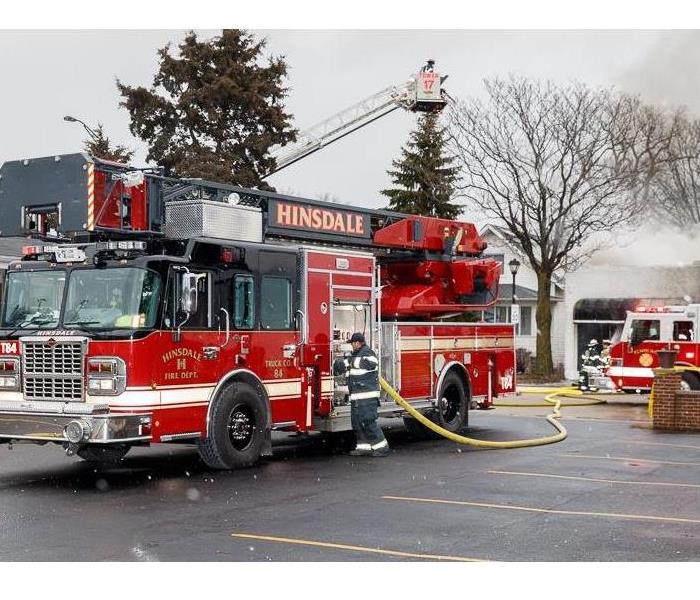 Fire Truck at Fire Station
Fire Truck at Fire Station
The fire has been put out by the firemen and they were able to save your family and your home. After they leave you walk back into your home onto saturated carpet, tile floors with puddles, charred walls and baseboards, soot, smoke odor and a huge hole in the wall where the fireman entered your home. This is a very devastating time in anyone’s life. This is when you call the Professionals for help. This is when you would call SERVPRO of Vermilion County (217)-443-0077. The SERVPRO Professionals have specialized in fire and water damage restoration and move quickly to clean up and restore your home to pre-fire condition
SERVPRO can do any size board up to secure your home. The board up is important in keeping your home safe and secure until work can be scheduled. The Company also extracts water and has dehumidifiers.
SERVPRO of Vermilion County can also take care of not only cleaning your sentimental items but are also equipped with the environmentally friendly cleaning products to clean your walls, carpet, and upholstery. SERVPRO also offers soda blasting. Soda blasting is also environmentally friendly and removes soot, badly charred and other types of residue caused by fire. The procedure may be used on brick, ceramic, glass, mortar, concrete and wood without damage. Along with cleaning it also helps to absorb the smoke odor.
SERVPRO provides equipment for helping with the odor. Air scrubbers, ozones and hydroxyls are 3 pieces of equipment that can be set up for odor. Once the structure has been cleaned and odor free, the Sevpro of Vermilion County also has a Construction Department for the put back.
We are here for you in your most difficult time. All you have to do is call 217-443-0077.
Different Classes of Fires
3/19/2020 (Permalink)
 Difference In Fire Classes
Difference In Fire Classes
The fire classification system is designed to categorize fires into groups based on the type of fuel involved. Each fire class is represented by a letter of the alphabet (with the electrical which are simply referred to as “electrical fires”) and an icon. This helps users to select an appropriate fire extinguisher in the event of a fire.
Class A Fires
- Solid Combustibles
- Fire involving solid combustible materials such as wood, textiles, straw, paper, coal etc.
Class B Fires
- Flammable Liquids
- Fire caused by combustion of liquids or materials that liquefy such as petrol, oils, fats, paints, tar, ether, alcohol, stearin, and paraffin.
Class C Fires
- Flammable Gases
- Fires caused by combustion of gases such as methane, propane, hydrogen, acetylene, natural gas and city gas.
Class D Fires
- Flammable Fires
- Fires involving combustibles metals such as magnesium, aluminum, lithium, sodium, potassium and their alloys. Combustible metal fires are unique industrial hazards which require special fire extinguishers.
Class F Fires
- Combustible Cooking Media
- Fires involving particularly hot or deep oil and grease fires, such as deep fat fryers in commercial kitchens or overheated oil pan fires in homes. Normal water-based extinguishers with large droplets would cause an ‘explosion’ of stream and carry burning oils and fats from the container. Equally, a CO2 extinguishers jet would carry burning oil out of the container and also would have in-sufficient cooling effect to stop reigniting. Wet chemical extinguishers, on the other hand, lay a cooling foam layer on top of the burning fat/oil and react with the liquid, stopping air supply to the fire.
Electrical Fires
- Electrical Appliances
- Fires involving electrical appliances such as computers, electrical heaters, stereos, fuse boxes etc.
Call SERVPRO of Vermilion County for any of your fire needs, 24/7 at (217) 443-0077.
5 Common Causes to Commercial Fires
1/10/2020 (Permalink)
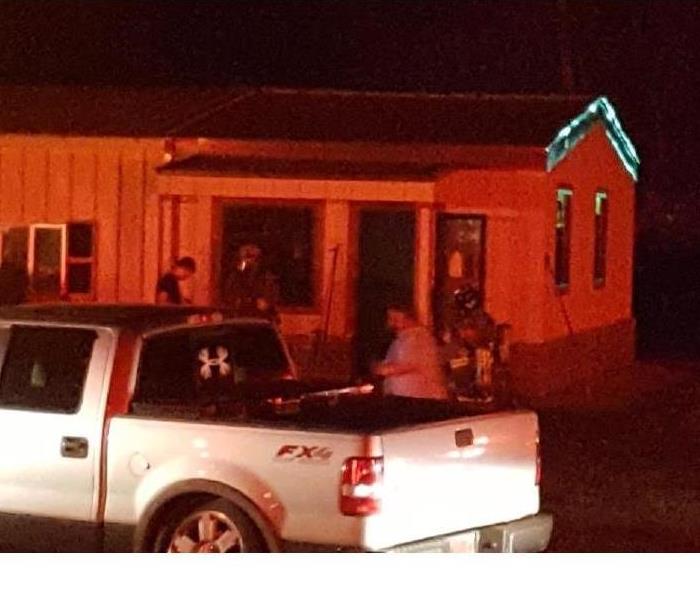 Vet Clinic Fire
Vet Clinic Fire
There are five common causes of fires in Commercial Buildings:
- Cooking Equipment
- Heating equipment
- Electrical & lighting equipment
- Smoking materials
- Intentional fire setting
SERVPRO of Vermilion County has the equipment, expertise, and experience for fire cleaning and smoke damage. A power surge affected a local business on Wednesday. The SERVPRO of Vermilion County crews had the business up running on Thursday. That was a 24-hour turnaround. The crews used the hepa-vac and cleaned the first floor, basement and boarded up windows. Crews also packed up all contents in the office where the fire began and deliver to the warehouse for storage. The remainder of the contents on both levels were cleaned on-site. The owner of the business was shocked but pleased that they were closed for only 1 day. You can count on SERVPRO of Vermilion County and their hard-working crew to be there for you and your business. Call SERVPRO of Vermilion County at 217-443-0077 for all your fire and smoke restoration needs. We will leave it "Like it never even happened."
5 Common Causes to Commercial Fires
12/10/2019 (Permalink)
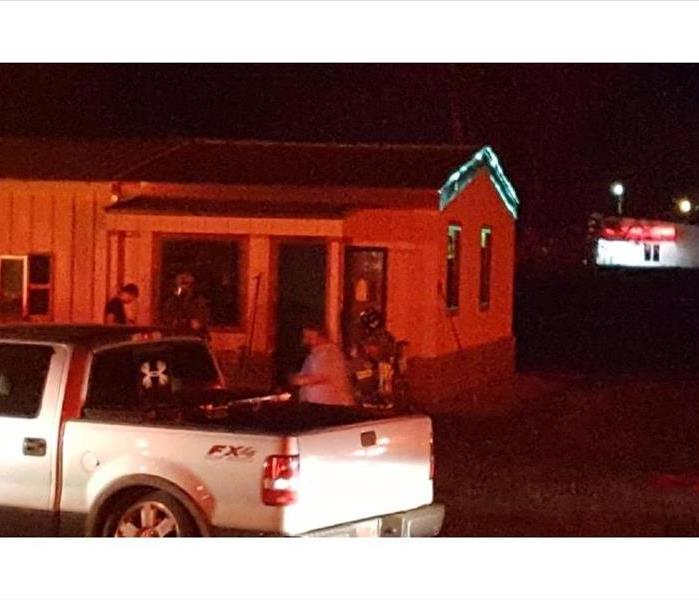 Vet Clinic Fire
Vet Clinic Fire
There are five common causes of fires in Commercial Buildings:
- Cooking
- Equipment Heating
- equipment Electrical
- lighting equipment
- Smoking materials
- Intentional fire setting
SERVPRO of Vermilion County has the equipment, expertise, and experience for fire cleaning and smoke damage. A power surge affected a local business on Wednesday. The SERVPRO of Vermilion County crews had the business up running on Thursday. That was a 24-hour turnaround. The crews used the hepa-vac and cleaned the first floor, basement and boarded up windows. Crews also packed up all contents in the office where the fire began and deliver to the warehouse for storage. The remainder of the contents on both levels were cleaned on-site. The owner of the business was shocked but pleased that they were closed for only 1 day. You can count on SERVPRO of Vermilion County and their hard-working crew to be there for you and your business. Call SERVPRO of Vermilion County at 217-443-0077 for all your fire and smoke damage needs. We will leave it like it never even happened.
Table Can Be Cleaned After Fire
11/27/2019 (Permalink)
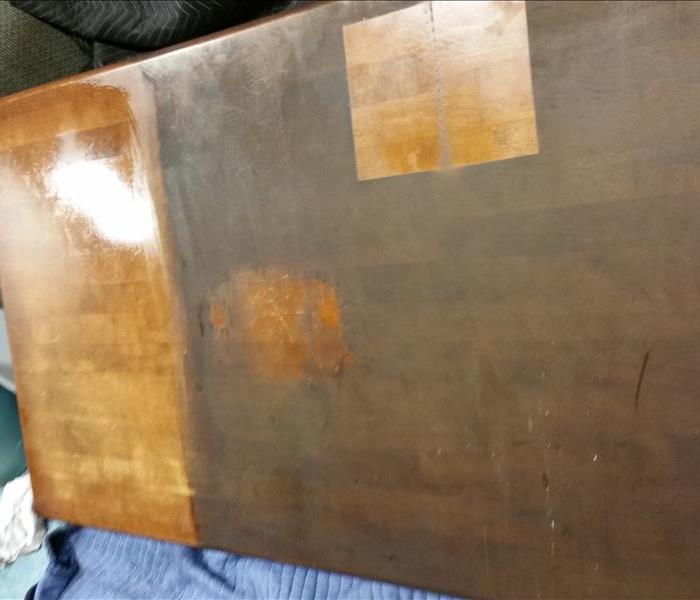 Fire table can be cleaned up instead of disposed of.
Fire table can be cleaned up instead of disposed of.
Some people may look at this table covered with soot from a house fire and believe that it is a total loss. However, these items are not a challenge for the crew at SERVPRO of Vermilion County! The crews are trained and have the proper products for this kind of fire clean up. It took one employee and about forty-five minutes to bring this table back to life. When the customer came to view his items, he could not believe his eyes. SERVPRO was not only able to clean and restore his table but also remove all of the smoke odor. He did not know the powers of SERVPRO of Vermilion County. Call us at 217-443-0077 for all your fire clean up and restoration needs.
Fire Damage Specialists
8/1/2019 (Permalink)
No one ever expects horrible things to happen inside their beautiful home. House fires are something that most people think will never happen to them. However, mishaps do take place, and one day it is possible that you have a fire inside your home.
Accidents happen, and many people find themselves in a situation where a minor fire starts in their home. If this ever happens to you, it's a good idea to call SERVPRO of Vermilion County's fire damage experts. Some people have small fires start inside their home, and they can quickly put it out.
However, even though you may not see an excessive amount of burn damage where the fire started it is still wise to call in SERVPRO of Vermilion County to inspect the damage. Many times a fire causes damage that is not in the exact area of the source of the blaze. When a fire burns, it creates an excessive amount of smoke that spreads to all areas of your home.
The smoke a fire produces can cause a surprising amount of damage. It can cause soot residue to build up on surfaces not close to where the fire started. A fire started in one room could possibly create odors that are present in other areas of your home. A fire sometimes embeds an unpleasant burn smell into contents inside your home.
Any of these issues, if not treated correctly, might result in permanent damage to your home. When you call in the professionals, it is now up to them to figure out every area of fire or smoke damage may have affected. Our staff is highly skilled at diagnosing in every unique situation. Our experienced team knows how to find things that get ruined in the most unexpected places. Our team also knows the best procedures and practices we can use to mitigate the problem.
We are IICRC certified and skilled in all areas of fire damage restoration. Our team uses the best equipment available in the industry to remove damage caused by the fire.
3 Items To Toss Away After a House Fire
7/31/2019 (Permalink)
Items inside your Vermilion County, home can be affected by fire in different ways.
When a fire affects your Vermilion County, home, you may be left wondering how to restore your valued belongings and what to throw away. While circumstances vary, there are a few possessions that may need to be tossed to ensure the safety of your family. As you work to return your home to normal, there are several common household items you should consider replacing once they have endured a fire.
1. Medicine
The effectiveness of some medicines may be impacted once they have been exposed to high heat. When you can re-enter your home safely, check your medicine cabinet or other areas where you store prescription medications. If the plastic bottles appear warped or have been exposed to fire extinguisher dust, they should be thrown away. Ask your pharmacy about replacement options and whether you can be compensated for lost meds.
2. Cosmetics
When some cosmetics suffer fire damage, they may no longer be safe to apply to your skin. Any cosmetics left out on vanities or dressers in rooms affected by the fire should be disposed of, as they might be coated with soot or ash that is difficult to see. It’s better to err on the side of caution, even if you take a loss on what you spent for your makeup.
3. Canned Foods
While you may be able to sanitize canned foods after a flood, fire and extreme temperatures can change the contents in ways that water cannot. Inspect your pantry’s contents carefully and throw away cans, dried goods and packages that have been visibly burned, appear warped or are coated with dried extinguisher foam.
Items inside your Vermilion County, home can be affected by fire in different ways. Knowing what to throw away after a blaze can protect your family from the possible contaminants that may be lurking in everyday items. For more information, visit https://www.SERVPROvermilioncounty.com/
How Professionals Clean Fire Extinguisher Residue From Your Manhattan Apartment
7/15/2019 (Permalink)
Fire suppression systems requires special cleanup.
Restoring Fire Suppression Damages in Your Vermilion County Apartment
Over range, fire suppression systems are becoming more and more common throughout Vermilion County homes and properties to reduce the fast spreading nature of kitchen flare-ups. While these might quickly put out a potential fire, it does not happen without damages and a mess of its own to face. Powder suppression can spread the extinguishing material throughout the affected area, and when coupled with smoke and soot damage from the small fire, can become problematic to overcome without the right training and equipment.
After a small kitchen flare-up that engaged the suppression system, you get your first look at the fire damage in your Vermilion County property. Residues from powder, smoke, and soot affect many of the surfaces in the immediate area and cleaning these as promptly as possible can reduce the possibility of staining. If the damage stays primarily contained within the kitchen, our SERVPRO team can isolate this area with the use of thick plastic sheeting and other containment strategies.
The wipe down process can reduce and eliminate a large portion of this residue from surfaces within the affected areas. Quickly cleaning these damaged surfaces can help to reduce the possibility of requiring replacement of certain materials by protecting and preserving cabinets, appliances, flooring, ceilings, and even the HVAC system if soot, smoke, and residual powder get pulled into the ductwork.
Lingering odors are another problem that property owners face after a kitchen fire. Our SERVPRO professionals have advanced equipment like our hydroxyl generators that can help to significantly reduce or permanently eliminate noxious odors throughout this kitchen area. The containment that isolated this affected region of your home can help to ensure the effectiveness of the deodorizing equipment.
Powder suppression systems can sometimes cause more of a mess than smaller fires that they work to prevent. Whether you need cleanup or a full restoration to your fire-damaged structure, our SERVPRO of Vermilion County restoration technicians can help.
Our rapid response team is available 24/7 by calling (217) 443-0077. We always help you in your time of need, "Like it never even happened."
Every Second Counts
6/17/2019 (Permalink)
In a fire, seconds count. Seconds can mean the difference between residents of our community escaping safely from a fire or having their lives end in tragedy.
This reinforces why everyone needs to have an escape plan. Here are some key messages to employ:
- Draw a map of your home with all members of your household, marking two exits from each room and a path to the outside from each exit.
- Practice your home fire drill twice a year. Conduct one at night and one during the day with everyone in your home, and practice using different ways out.
- Teach children how to escape on their own in case you can’t help them.
- Make sure the number of your home is clearly marked and easy for the fire department to find.
- Close doors behind you as you leave – this may slow the spread of smoke, heat, and fire.
- Once you get outside, stay outside. Never go back inside a burning building.
via http://www.nfpa.org/
Have you contacted your local fire department? See how you can get involved with them and your community to prevent house fires. Sometimes they will have events or give out smoke detectors for your home. Don't think this could never happen to you because it easily could. We don't have control over everything in our homes! Be safe and have a plan! [JB]
Reach SERVPRO of Vermilion County at (217)443-0077.
3 Fire Hazards to Avoid This Spring
4/15/2019 (Permalink)
Springtime is such a fun, beautiful time of year. Stay safe out there!
The weather is warmer, the trees are blooming, and my allergies are killing me. Spring has officially sprung! That being said, there are still a wide variety of fire hazards that you should watch out for, even during the warm months.
1.Grills: Whether you’re cooking burgers for the family event or grilling up kabobs for dinner, you will inherently deal with a fire. Most are gas grills, which presents an even greater risk. In fact, the NFPA (https://www.nfpa.org/News-and-Research/Data-research-and-tools/US-Fire-Problem/Home-Grill-Fires) reports that an average of 9,600 home fires is caused by grilling each year. Here are some fire safety tips for the grill:
- Always check for any potential fire hazards before firing up the grill.
- If the grill does not light the first time, let the gas dissipate for at least 5 minutes before attempting to light the grill again.
- Be sure the grill is clean before using to get rid of oil and gas residue.
- Make sure the grill is set up in an open, outdoor area and keep it a good distance from the house and railings.
- Dryers: This is a fire hazard year round. In fact, the leading cause of clothes-dryer related fires is a failure to keep the lint baskets clean. Lint is combustible. Lint causes fires. It takes seconds to clean out the lint basket, so just make a habit of it when you get your clothes out of the dryer. If you have space for a clothesline in the spring and summer months - use it! There’s nothing better than fresh, air dried clothes. The NFPA also recommends cleaning out the vent pipe at least once a year so lint or other flammable particles do not get stuck in the vent pipe.
- Outdoor Fire Pits and Bonfires: The necessary safety precautions for an outdoor fire pit are pretty obvious, but keep these in mind when you’re having a party on a cool spring night.
- Always have an adult present around a fire. Never leave children unattended!
- Always have a bucket of water or a water hose available nearby if things get out of hand.
- Build the fire away from homes, porches, low-hanging trees, or any other fire hazards.
- Monitor the number of leaves, pine needles, paper, and other contents are fed into the fire since these items catch fire quickly and result in high flames and floating embers.
- Always put the fire out completely before leaving the fire unattended. Don't expect it to die down on its own!
We are always Here to Help when you need us. Call us at SERVPRO of Vermilion County any time at (217)443-0077. Happy Spring!
Why hiring a professional restoration company to clean up after your home experiences a fire is the best choice
3/4/2019 (Permalink)
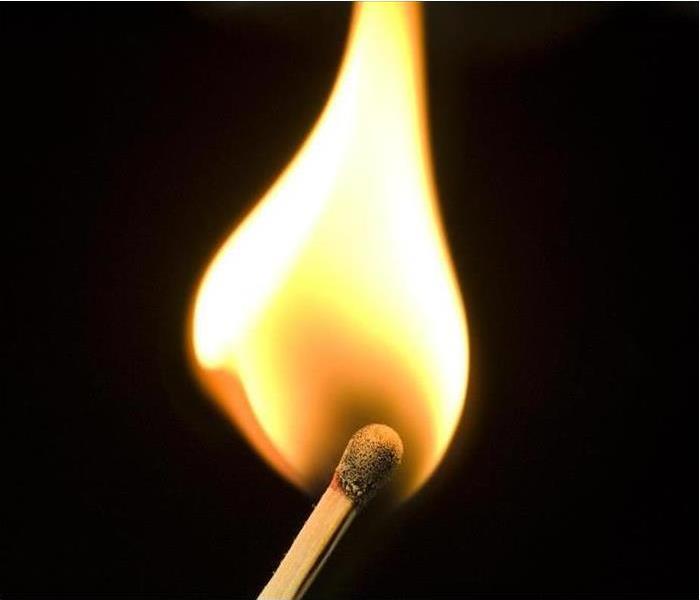 Fire damage in Vermilion County does not have to be a headache
Fire damage in Vermilion County does not have to be a headache
The principle of cleaning after fire damage in Vermilion County
Surviving the aftermath of the fire damage can be quite a relief. However, the replacement and repairs can be very detrimental. Luckily, there are some insurance companies out there who would help with the costs. However, dealing with the aftermath does require some skills and expertise. The cleaning process isn’t an easy task. Keep in mind that it requires extensive inspection, identifying types of residues and services, removing the residues and disposal. All this should be taken care of by a fire restoration specialist. After all, doing this on your own can be very dangerous, exhausting, time-consuming, and expensive.
Fire damage in Vermilion County does not have to be a headache. The situation is mainly because the SERVPRO tech can take care of everything. They can start by inspecting that areas near the source of the fire and see how far the damage has moved through various structures. There are different types of smoke residues, and the SERVPRO specialist can select a cleaning method that can effectively remove these residues. Another thing to note is that the type of surface that has undergone the fire damage may require specialized cleaning method and products that are sale to use on the surface. The fire restoration experts may have to be cautious to preserve the materials or surface during the cleaning process.
Since smoke residues can bind to the surface that they come in contact with, the fire experts can use a dry and wet screening process to release the particles away from the affected surface. The restorer can adequately get rid of the debris and cleaning waste. Once everything is completed, the technicians can walk you through your how to make sure that you are satisfied with the results.
If you are interested in getting a specialist to clean and restore you home after fire damage, then give SERVPRO of Vermilion County a call at (217)443-0077 and we can promptly send our experts to your home. (LB)
Smoke and Soot Cleanup
2/7/2019 (Permalink)
Smoke and soot is very invasive and can penetrate various cavities within your home, causing hidden damage and odor. Our smoke damage expertise and experience allows us to inspect and accurately assess the extent of the damage to develop a comprehensive plan of action.
Smoke and soot facts:
- Hot smoke migrates to cooler areas and upper levels of a structure.
- Smoke flows around plumbing systems, seeping through the holes used by pipes to go from floor to floor.
- The type of smoke may greatly affect the restoration process.
Different Types of Smoke
There are two different types of smoke–wet and dry. As a result, there are different types of soot residue after a fire. Before restoration begins, SERVPRO of Vermilion County will test the soot to determine which type of smoke damage occurred. The cleaning procedures will then be based on the information identified during pretesting. Here is some additional information:
Wet Smoke – Plastic and Rubber
- Low heat, smoldering, pungent odor, sticky, smeary. Smoke webs are more difficult to clean.
Dry Smoke – Paper and Wood
- Fast burning, high temperatures, heat rises therefore smoke rises.
Protein Fire Residue – Produced by evaporation of material rather than from a fire
- Virtually invisible, discolors paints and varnishes, extreme pungent odor.
Our Fire Damage Restoration Services
Since each smoke and fire damage situation is a little different, each one requires a unique solution tailored for the specific conditions. We have the equipment, expertise, and experience to restore your fire and smoke damage. We will also treat your family with empathy and respect and your property with care.
Have Questions about Fire, Smoke, or Soot Damage?
Call Us Today – (217) -935-2992
Emergency Tips: Fire/Smoke Damage Do's and Don'ts
1/14/2019 (Permalink)
Do
- Limit movement in the home to prevent soot particles from being embedded into upholstery and carpet.
- Keep hands clean; Soot on hands can further soil upholstery, walls, and woodwork.
- Place dry, colorfast towels or old linens on rugs, upholstery and carpet traffic areas.
- If electricity is off, empty freezer and refrigerator completely and prop doors open to help.
- Wipe soot from chrome on kitchen and bathroom faucets, trim, and appliances, and then protect these surfaces with a light coating of lubricant.
- If heat is off during winter, pour RV antifreeze in sinks, toilet bowls, holding tanks and tubs to avoid freezing pipes and fixtures.
- Wash both sides of leaves on house plants.
- Change HVAC filter, but leave system off until a trained professional can check the system.
Don't
- Attempt to wash any walls to painted surfaces without first contacting your SERVPRO Franchise Professional.
- Attempt to shampoo carpet or upholstered furniture without first consulting your SERVPRO Franchise Professional.
- Attempt to clean any electrical appliances (TV sets, radios,etc.) that may have been close to fire, heat, or water without first consulting an authorized repair service.
- Consume any food or beverages that may have been stored close to fire, heat, or water (may be contaminated)
- Turn on ceiling fixtures of ceiling is wet. Wiring may be wet or damaged and cause electrical shock, and air movement may create secondary damage.
- Send garments to dry cleaner. Improper cleaning may set in smoke odor.
Call SERVPRO of Vermilion County today with any of your Fire and Water damage needs at (217) 443-0077.
Holiday Fire Safety Tips
11/26/2018 (Permalink)
Residential fires during the holiday season are more frequent, more costly, and more deadly than at any other time of the year. The U.S. Fire Administration (USFA) reports more than double the number of open-flame fires on Christmas Day than on an average day, and about twice as many on New Year’s Day. And when those fires occur, they do more damage: Property loss during a holiday fire is 34% greater than in an average fire, and the number of fatalities per thousand fires is nearly 70% higher. When the source of the fire is a highly flammable Christmas tree, the toll in property and lives is even greater.
To keep your household from becoming a holiday fire statistic, here are some safety tips to follow.
Cooking
Cooking is the top cause of holiday fires, according to the USFA. The most common culprit is food that’s left unattended. It’s easy to get distracted; take a pot holder with you when you leave the kitchen as a reminder that you have something on the stove. Make sure to keep a kitchen fire extinguisher that’s rated for all types of fires, and check that smoke detectors are working.
If you’re planning to deep-fry your holiday turkey, do it outside, on a flat, level surface at least 10 feet from the house.
Candles
The incidence of candle fires is four times higher during December than during other months. According to the National Fire Protection Association, four of the five most dangerous days of the year for residential candle fires are Christmas/Christmas Eve and New Year’s/New Year’s Eve. (The fifth is Halloween.)
To reduce the danger, maintain about a foot of space between the candle and anything that can burn. Set candles on sturdy bases or cover with hurricane globes. Never leave flames unattended. Before bed, walk through each room to make sure candles are blown out. For atmosphere without worry, consider flameless LED candles.
Christmas Trees
It takes less than 30 seconds for a dry tree to engulf a room in flames, according to the Building and Fire Research Laboratory of the National Institute for Standards and Technology. “They make turpentine out of pine trees,” notes Tom Olshanski, spokesman for the USFA. “A Christmas tree is almost explosive when it goes.”
To minimize risk, buy a fresh tree with intact needles, get a fresh cut on the trunk, and water it every day. A well-watered tree is almost impossible to ignite. Keep the tree away from heat sources, such as a fireplace or radiator, and out of traffic patterns. If you’re using live garlands and other greenery, keep them at least three feet away from heating sources.
No matter how well the tree is watered, it will start to dry out after about four weeks, Olshanski says, so take it down after the holidays. Artificial trees don’t pose much of a fire hazard; just make sure yours is flame-retardant.
Decorative Lights
Inspect light strings, and throw out any with frayed or cracked wires or broken sockets. When decorating, don’t run more than three strings of lights end to end. “Stacking the plugs is much safer when you’re using a large quantity of lights,” explains Brian L. Vogt, director of education for holiday lighting firm Christmas Décor. Extension cords should be in good condition and UL-rated for indoor or outdoor use. Check outdoor receptacles to make sure the ground fault interrupters don’t trip. If they trip repeatedly, Vogt says, that’s a sign that they need to be replaced.
When hanging lights outside, avoid using nails or staples, which can damage the wiring and increase the risk of a fire. Instead, use UL-rated clips or hangers. And take lights down within 90 days, says John Drengenberg, director of consumer safety for Underwriters Laboratories. “If you leave them up all year round, squirrels chew on them and they get damaged by weather.”
Fireplaces
Soot can harden on chimney walls as flammable creosote, so before the fireplace season begins, have your chimney inspected to see if it needs cleaning. Screen the fireplace to prevent embers from popping out onto the floor or carpet, and never use flammable liquids to start a fire in the fireplace. Only burn seasoned wood — no wrapping paper.
When cleaning out the fireplace, put embers in a metal container and set them outside to cool for 24 hours before disposal.
Should you have a fire emergency, no matter how big or how small, we here at SERVPRO are ready to help 24 hours a day! Call us today at (217)935-2992.
70,000 fire disasters per year
7/10/2018 (Permalink)
In just 2 minutes, a fire can become life-threatening. In 5 minutes, a residence can be engulfed in flames.
Have a plan:
- Find 2 ways to get out of each room.
- Make sure windows are not stuck and can be used as an exit if needed.
- Practice feeling your way around the house with your eyes closed or in the dark.
- Teach children not to be afraid of firefighters.
During a fire:
- Crawl low under the smoke to closest exit.
- Check doorknobs and door for heat. If it is hot, find alternate exit.
- If your clothes catch fire, stop, drop, & roll.
After a fire:
- Contact insurance company if insured.
- Check with fire department before entering the residence again.
- Do not reconnect utilities yourself.
- Conduct inventory of damaged items.
- Try to locate valuable documents and records.
Keep Calm and Call SERVPRO
of Vermilion County
(217) 443-0077
Smoke Detectors
5/25/2018 (Permalink)
You really can never be too prepared. Fires can happen anywhere, at any time...under the right conditions. The preventative measures you take prior to a potential fire loss could save your home, or more importantly your life! Replacing the batteries in your smoke detectors twice a year is a must. A good rule of thumb is when you change the clocks change the batteries in the smoke alarms, this will provide consistent battery life in your detectors. This gives you a chance to check your smoke detectors to make sure they working properly. Put an evacuation plan together. Make sure your loved ones and those living with you know what to do in the event of a fire. Having a central location to meet once everyone is outside is a great plan. After you and your loved ones are safe, call SERVPRO to make it "Like it never even happened."
Smoke & Soot Cleanup
11/30/2017 (Permalink)
Smoke and soot is very invasive and can penetrate various cavities within your home, causing hidden damage and odor. Our smoke damage expertise and experience allows us to inspect and accurately assess the extent of the damage to develop a comprehensive plan of action.
Smoke and soot facts:
- Hot smoke migrates to cooler areas and upper levels of a structure.
- Smoke flows around plumbing systems, seeping through the holes used by pipes to go from floor to floor.
- The type of smoke may greatly affect the restoration process.
Different Types of Smoke
There are two different types of smoke–wet and dry. As a result, there are different types of soot residue after a fire. Before restoration begins, SERVPRO of Vermilion County will test the soot to determine which type of smoke damage occurred. The cleaning procedures will then be based on the information identified during pretesting. Here is some additional information:
Wet Smoke – Plastic and Rubber
- Low heat, smoldering, pungent odor, sticky, smeary. Smoke webs are more difficult to clean.
Dry Smoke – Paper and Wood
- Fast burning, high temperatures, heat rises therefore smoke rises.
Protein Fire Residue – Produced by evaporation of material rather than from a fire
- Virtually invisible, discolors paints and varnishes, extreme pungent odor.
Our Fire Damage Restoration Services
Since each smoke and fire damage situation is a little different, each one requires a unique solution tailored for the specific conditions. We have the equipment, expertise, and experience to restore your fire and smoke damage. We will also treat your family with empathy and respect and your property with care.
Have Questions about Fire, Smoke, or Soot Damage?
Call Us Today – (217) 443-0077





 24/7 Emergency Service
24/7 Emergency Service

